Blue Ocean Shift Book from Chan Kim & Renée Mauborgne – My Top 5 Learnings
Rating, Summary, Author & a lot more
Page Calculator:
Top 5 Keylearnings from the Blue Ocean Shift Book
The book Blue Ocean Shift is a guide on how to create and develop new markets for yourself. Here are my top 5 keylearnings:
1. New markets are not as far away as you think. It can be a small change in your value proposition that sets you apart from the competition. Think of the Cirque du Soleil. They “just” left out the animals.
2. Paint your strategy on the canvas. With their strategy canvas, the authors have created an incredible, yet so simple strategy tool. You draw the most important competitive factors in a coordinate system on the X axis and how high the value of your offer is for this factor on the Y axis. You do the same with all of your competitors. You can already see in which area everyone is bustling and where there is still a lot of potential.
3. I’m not a machine. In many non-fiction books on market theories, the most important point is often left out. The point why most plans fail. Humanity. The book Blue Ocean Shift goes into this topic in detail and emphasizes the importance of meeting everyone involved and taking their fears and insecurities seriously. It is not child’s play to throw yourself into a blue ocean.
4. Think about your non-customers. Don’t choose the audience that all of your competitors want to win. Instead, identify the pain points, which is why all other target groups do not use the product. Think about the Nintendo Wii. Nintendo realized that most people don’t play video games just because they’re sitting around. But most of them want to move.
5. After buying is before buying. Take a close look at all phases after purchasing your product. What happens during delivery, use, additional equipment, maintenance and disposal? Where can you stand out from the market?
 Who is Chan Kim & Renée Mauborgne?
Who is Chan Kim & Renée Mauborgne?
The two authors published their book Blue Ocean Strategy in 2004. This book has completely changed the image of markets. It has been translated into over 30 languages and is considered standard reading for developing new markets at elite universities. It is a bestseller on all 5 continents. Both authors were named among the top 3 management gurus in the world.
Renée and Chan are both professors at various universities. After the book’s success, they founded the Blue Ocean Global Network. The aim of this company is to spread the knowledge of the Blue Ocean Strategy worldwide. There is a special training to become a Blue Ocean Practitioner. They both appear regularly at major events.
Applicability of what has been learned from Blue Ocean Shift
The contents are well explained and illustrated with some graphics. The many examples of companies that have successfully managed a Blue Ocean Shift also help to understand the system.
Still, creating a new market is a mammoth project. It takes innovation, team power, reach and a little luck is also part of it. You can’t really apply the content. At least not right away. It is not without reason that the authors offer training courses for the Blue Ocean Strategy in their company.
The book helps you to look at markets in a new way. Don’t be satisfied with the given conditions. Look at the fitness market, for example, from a new perspective. Don’t think in the discounter, medium-priced and premium categories. What else is there. What can you add or even leave out? In the book there are so many examples of companies that have created a blue ocean through simple changes.
For all companies and start-up founders who want to create something new, the book is a must-read!
Comprehensibility of the content from Blue Ocean Shift
The book Blue Ocean Shift is peppered with dozens of real-world business examples. This makes this rather economic and abstract topic very understandable and practical. The chapters are well structured and with one chapter per day you will find a good reading speed.
You should definitely try out the tools presented. The canvas strategy in particular lets you immediately think about new markets. All of these tools are explained with graphics.
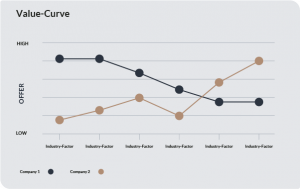
Even though I can only speak two languages really fluently, I find it impressive how many languages the book has been translated into. That gives extra plus points for the intelligibility.
Blue Ocean Shift explained in 750 Words
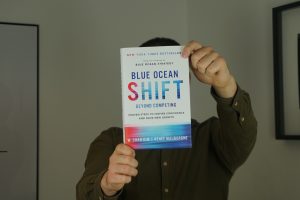
The metaphor behind the book is very easy to understand. A market (ocean) with a lot of competition (sharks) and few customers (fish) is blood red. Every customer is fought fiercely. In a blue ocean, you are the only one in your market and you have tons of customers.
So far so nice. Every entrepreneur wants a market in which I am the only supplier, i.e. have a monopoly. But the big question is how do I find such a blue ocean? The authors developed a 5-step plan.
Before we go into the step-by-step plan, let’s take a look at specific examples of how new markets are created.
- Digital photography was such an innovative invention that it fundamentally changed the entire industry. Keyword Kodak. A new market is created by developing an innovative product that makes the old ones obsolete.
- Viagra was developed by the pharmaceutical company Pfizer. Actually discovered more by accident. By discovering this drug, they created a new market for a previously neglected and unsolved problem.
- Are there any healthy fries? Groupe SEB dealt with this question. She developed a hot air fryer that uses just one tablespoon of oil and still prepares crispy and tasty French fries. In doing so, they created a market by redefining a known problem that can only be solved through their product.
Stage 1. Get started
To get started, you get an idea of the current product portfolio of your company. The authors have developed a pioneer-migrant-settler matrix for this purpose. On this you enter your current products and examine which of them are the most promising.
At this stage you also take care of your team. You can’t create a blue ocean on your own. You need the help of many other people for this. That is why humanity is an important part of a blue ocean shift. The authors have three tips for this topic as well.
- Break down the major project Blue Ocean Shift into many small subtasks. That motivates and the management is much easier.
- Diamonds are created under pressure, but not good ideas. All parties involved must understand the necessity of the change of strategy for themselves.
- You can contribute to success through your own thoughts and actions.
- In order to take all employees with you, you have to think of these three factors: Involvement – declaration – decision. Involve all employees in the project. Explain to them why this decision is necessary and what their role and expectations are.
Step 2. Define the current status
Now it’s about realizing the company’s own strengths and the realities of the industry / market. For this you use the strategy canvas. You draw the most important competitive factors in a coordinate system on the X axis and how high the value of your offer is for this factor on the Y axis. You do the same with all of your competitors. You can already see in which area everyone is bustling and where there is still a lot of potential.
With the Strategy Canvas in place, it’s time to convince everyone on the team that it’s time for a blue ocean.
Step 3. Define the target level
Investigate the buyer’s journey. What steps does the customer go through after purchasing the product. Where are the biggest pain points and how can you use them for yourself.
Why are there so many non-customers for this market. Ask the target groups who don’t use your product. Find out why this is out of the question for you. Can you develop a product that can convince this target group?
Level 4. Finding out the way to get there
With the help of the Six-Paths Framework you can find out what market barriers there are for a blue ocean:
Path 1 – Check out alternative industries
Path 2 – Look at strategic groups within your industry
Path 3 – Look at the different buying decision makers
Path 4 – Check out complementary products
Path 5 – Consider the functional and emotional alignment of your industry
Path 6 – Create sustainable external trends
In addition, you use the Four Actions Framework at this stage. So you decide which factors can be
eliminated – reduced – increased – generated
This allows you to stand out from your competition and move into new, fresh markets.
Level 5. Set sail
After you’ve gone through all of the steps, it’s time to make your findings public. First, you invite all those involved in the company (investors, department heads, suppliers, etc.) and present them with the findings from levels 1-4. Everyone needs to understand the necessity and their role in this blue ocean shift.
Rapid market tests are then carried out in the individual departments to validate the assumptions. After these tests, the big picture is written down in a business model. The business model must be a win-win situation for the company and the customers.
From then on it is time to set sail and head for the Blue Ocean.
Why you should read Blue Ocean Shift book when you are doing the Power MBA
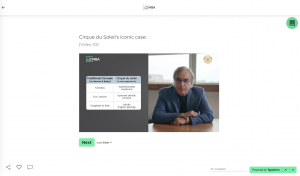
The book Blue Ocean Strategy and the new edition with Blue Ocean Shift are standard works of modern market theory. Especially in today’s world, where there are already so many solved problems, new perspectives on markets and problems have become all the more important. The 8 lessons in the Power MBA advanced training program only deal with the topic of Blue Ocean Strategy. The CEO of Cirque du Soleil uses specific figures to show how her company has developed with this strategy. He also goes into the current challenges posed by the Corona crisis and what measures they have developed to keep operations alive.
As a preparation for the PMBA, I definitely recommend you to read the Book Blue Ocean Shift*.

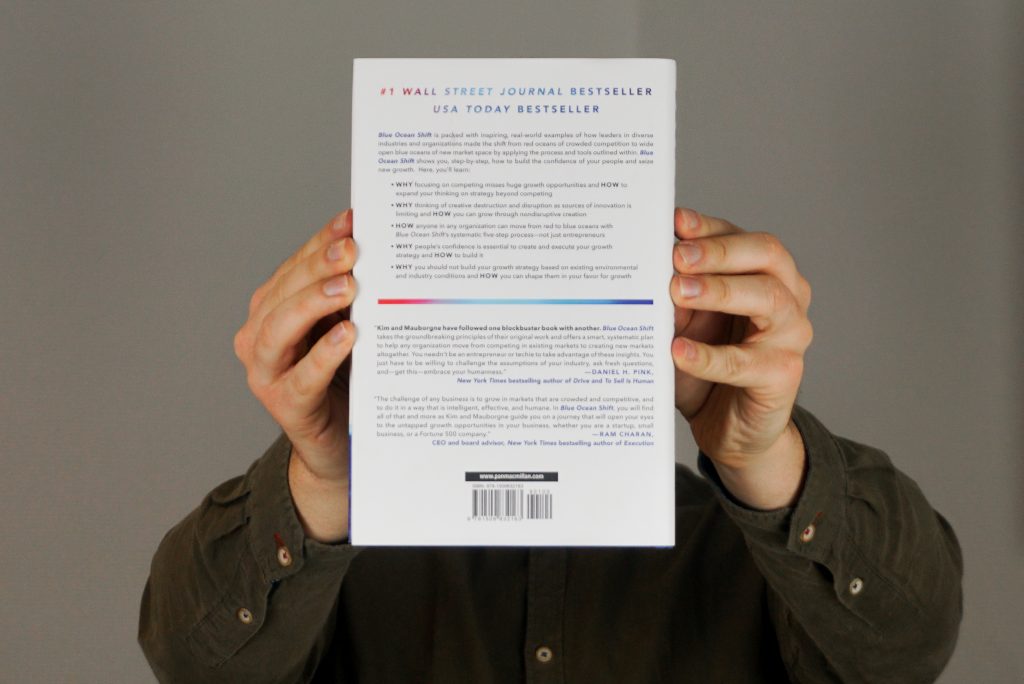
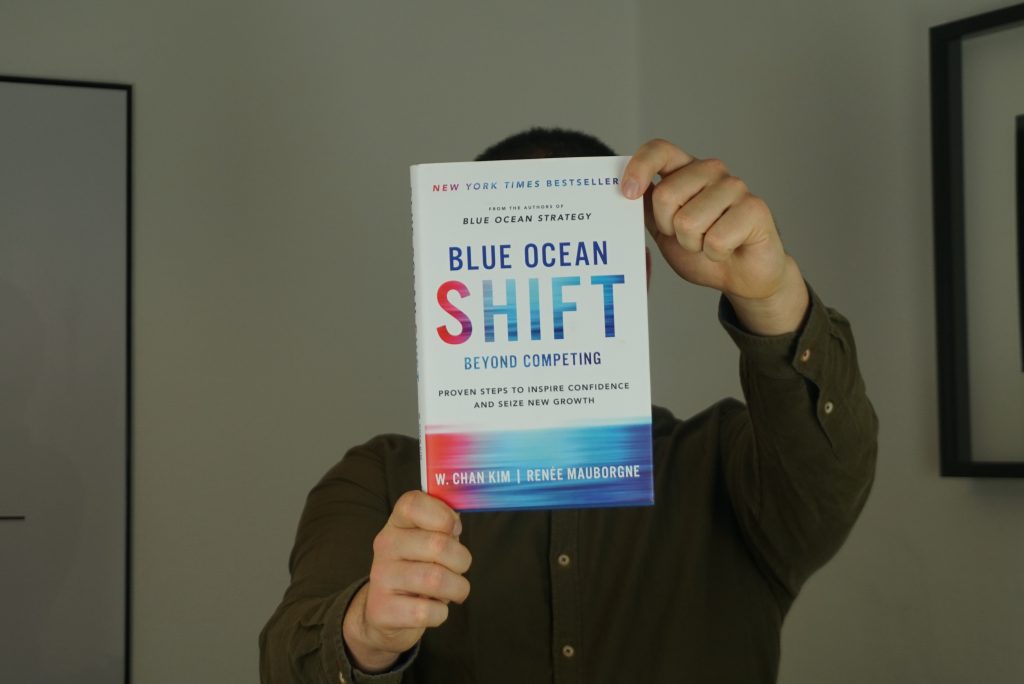
 Who is Chan Kim & Renée Mauborgne?
Who is Chan Kim & Renée Mauborgne?